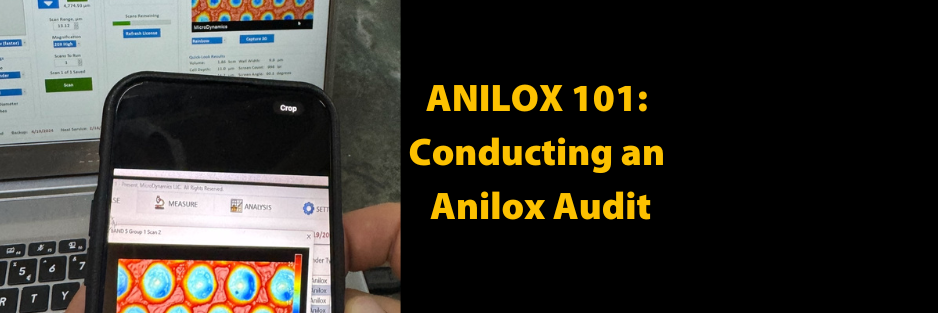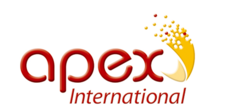
In the fast pace flexo industry, knowledge fuels performance. As presses and processes become more automated, printers must take a closer look at the few variables in the process, especially anilox selection. Conducting an anilox audit to control the foundation of the process is a sure way to understand your anilox inventory and gain more direction in setting up streamlined processes for success.
What is an Anilox Audit?
An anilox audit is a comprehensive assessment of your anilox inventory, processes, and performance metrics, in relation to a printer’s unique operations. An audit will evaluate variables such as anilox engraving and  performance, cleaning and maintenance, handling and storage, and more.
performance, cleaning and maintenance, handling and storage, and more.
Thorough anilox audits identify key performance indicators (KPIs) and provide insight for continuous improvement. Printers that invest in anilox quality control can make strides towards profitable automation.
Schedule an anilox audit with Apex International.
Conducting a Comprehensive Anilox Audit
As the world’s largest provider of anilox solutions, Apex International knows anilox audits. Here is our recommendations for conducting a comprehensive anilox quality assessment.
Step 1: Define Goals + Responsibilities
The first step of conducting an anilox audit is to designate an anilox QC team, method of collaboration, and set the goals of your audit. We recommend including an anilox technician, maintenance technician, and production manager in your audit team, if available. Define the purpose of your anilox audit – is it to effectively consolidate your anilox inventory? Are you trying to implement expanded color gamut? Are you struggling with downtime for cleaning? Do you have density variability from anilox to anilox? Ultimately, what is the goal of your audit? This will keep the audit process focused and streamlined with clear KPIs and outcomes.
Step 2: Evaluate Your Order Mix
To understand what aniloxes are best for your operations, you need to understand your order mix. What are your most profitable and consistent orders? Process work, block letters, flood coats, specialty printing, etc.? Do you deploy color builds or spot color? ECG? Short runs? Long runs? Additionally, incorporate future goals, such as ECG, for diversification and increased market share into your audit considerations. By evaluating your top application needs, you can carve out a framework for effectively auditing your anilox inventory.
Step 3: Survey Your Operators + Processes
 You may be surprised to hear that your operators have a “favorite” anilox roll or sleeve specification. It’s important to take note of which aniloxes and why. Capture unseen qualitative data by discussing with operators and maintenance on their experience with anilox performance, cleaning and processes. Questions such as: What anilox specifications are your go-to for troubleshooting? Which require the most cleaning? What caused damage to the anilox roll? Any feedback to improve cleaning and maintenance processes? Appraise your printing, cleaning, maintenance, handling, and storage processes thoroughly by speaking with those that interact with them most. This will provide a more comprehensive assessment that will lead to full optimization.
You may be surprised to hear that your operators have a “favorite” anilox roll or sleeve specification. It’s important to take note of which aniloxes and why. Capture unseen qualitative data by discussing with operators and maintenance on their experience with anilox performance, cleaning and processes. Questions such as: What anilox specifications are your go-to for troubleshooting? Which require the most cleaning? What caused damage to the anilox roll? Any feedback to improve cleaning and maintenance processes? Appraise your printing, cleaning, maintenance, handling, and storage processes thoroughly by speaking with those that interact with them most. This will provide a more comprehensive assessment that will lead to full optimization.
Step 4: Inspect Your Anilox Inventory
The anilox inspection process is now faster, easier and more accurate than ever with Veritas and MicroScan3. We encourage converters to incorporate regular anilox inspections into their standard operating procedures to record anilox data and performance over the life of the roll. We recommend inspecting your anilox rolls and sleeves at the following intervals:
- When receiving aniloxes from the supplier
- Immediately before and after production
- Before and after regular cleaning processes
These data points will help you understand anilox performance over time, key data thresholds that indicate maintenance or cleaning is required, the effectiveness of your cleaning efforts, your most used anilox specifications and much more.
Step 5: Assess Your Observations
 Now that you have acquired both qualitative and quantitative data on your anilox operations, assess the story your data is telling you. Using the MicroScan3 database, you can analyze your anilox KPI history, incorporate known quality metrics and draw conclusions about the state of your anilox inventory. An audit will help you find answers to strategic questions like: What are your most and least used anilox specifications? Why? What ink, anilox engraving, doctor blade, and plate combination works the best, consistently? What products/processes are impacting the success or failure of anilox cleaning? What anilox has the best ROI? Where are your biggest areas for improvement?
Now that you have acquired both qualitative and quantitative data on your anilox operations, assess the story your data is telling you. Using the MicroScan3 database, you can analyze your anilox KPI history, incorporate known quality metrics and draw conclusions about the state of your anilox inventory. An audit will help you find answers to strategic questions like: What are your most and least used anilox specifications? Why? What ink, anilox engraving, doctor blade, and plate combination works the best, consistently? What products/processes are impacting the success or failure of anilox cleaning? What anilox has the best ROI? Where are your biggest areas for improvement?
Ultimately, your anilox audit should bring to light the mix of solutions and processes that are best suited for your applications, along with those that need to change.
Step 6: Take Action
Don’t let your anilox audit stop at final assessments – it’s important to take action. You can make better decisions that impact your bottom line when you utilize the comprehensive knowledge of your anilox inventory, in relation to your operations. A strategic anilox audits may inspire action such as:
- Recondition unused or under-performing anilox rolls to top performing specifications
- Provide objective feedback to your suppliers for better products, support and service
- Consolidate and streamline your anilox inventory for top performing specifications
- Formalize SOPs for the best anilox inspection and cleaning practices found in the audit
- Re-schedule maintenance intervals based on performance thresholds seen
An experienced anilox supplier, like Apex International, can advise you on key actions to take after your anilox audit so you can focus on progress.
Example Audit Scenario
This fictitious scenario is based on a real case study data, conducted by Apex International.
 John Stevens, the owner of Precision Flexo Printing, partnered with Apex International to address ink consumption issues. They conducted an anilox audit using Veritas and MicroScan3, inspecting rolls with 3.5 µm ink film thickness, 400 L/cm (1015 lpi) line count, and various cell wall widths. The audit revealed that the Hex1 roll, with a 4.7 µm cell wall thickness, had the highest ink transfer at 12.0%, while deeper, narrower cells like those in Hex2 and Hex3 transferred less ink. Long cell engravings at 400 L/cm (1015 lpi) showed the highest ink transfer at 12.9%. Given the data, John streamlined inventory to remove rolls that were consuming too much ink and reconditioned these rolls to the innovative engravings from Apex. These aniloxes have a wider, shallower geometry that allows for more ink transfer, without increasing the ink consumption.
John Stevens, the owner of Precision Flexo Printing, partnered with Apex International to address ink consumption issues. They conducted an anilox audit using Veritas and MicroScan3, inspecting rolls with 3.5 µm ink film thickness, 400 L/cm (1015 lpi) line count, and various cell wall widths. The audit revealed that the Hex1 roll, with a 4.7 µm cell wall thickness, had the highest ink transfer at 12.0%, while deeper, narrower cells like those in Hex2 and Hex3 transferred less ink. Long cell engravings at 400 L/cm (1015 lpi) showed the highest ink transfer at 12.9%. Given the data, John streamlined inventory to remove rolls that were consuming too much ink and reconditioned these rolls to the innovative engravings from Apex. These aniloxes have a wider, shallower geometry that allows for more ink transfer, without increasing the ink consumption.
Aniloxes that Measure Up
When done right, your anilox audit should bring to light not only the best anilox specifications, but also the best anilox partner, for your operations. The audit will identify your best and worst performing aniloxes, and you may see a pattern among different anilox brands. Apex International has utilized feedback and insight from anilox audits to continuously improve our anilox solutions to ensure our solutions remain top of the audit board. UltraCell and GTT 2.0 are two anilox solutions developed by Apex International to combat common pressroom challenges and exceed performance standards. Backed by our warranty and quality assurance program, Apex anilox solutions are manufactured with the tightest OEM tolerances and advanced metallurgy.
The GTT 2.0 is a patented open slalom channel engraving designed to mitigate liquid turbulence and enhance print quality and press performance. The new, improved engraving is designed with a 50% reduction in  cell wall surface area across the anilox, with a decrease in the required channel depth by an average of 25%. With its shallow, open channel geometry, GTT is proven to reduce or eliminate ink spitting, mottling, pinholing, plugging and dot gain.
cell wall surface area across the anilox, with a decrease in the required channel depth by an average of 25%. With its shallow, open channel geometry, GTT is proven to reduce or eliminate ink spitting, mottling, pinholing, plugging and dot gain.
The UltraCell engraving is another Apex anilox innovation, engraved with an ultra-shallow cell geometry and a melted / fused inner cell wall for greater ink release and faster clean up. The controlled engraving process allows a more efficient ink / coating transfer, easier roll cleaning, and ultra resistance to anilox corrosion and scoring. UltraCell is available in Hex 60°, 75° longcell, trihelical, channellox, and 45° quad, are manufactured using multi-phase laser technology for the tightest OEM tolerances and the highest quality in print and coating applications.
Contact Apex International to get started with a comprehensive anilox audit and discover the variables driving your anilox performance.



